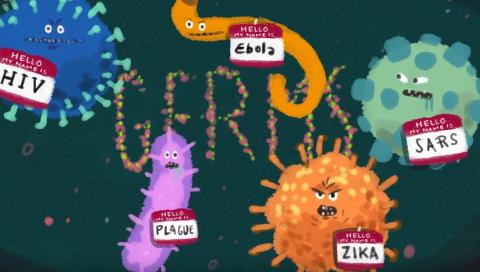A short, animated history of humans, germs and pandemics

How many ways are there to communicate science in society today? New and promising communication opportunities are rising fast, thanks to different media: web, social networks, graphic journalism like the webcomic strip dedicated to the potential public health issue represented by Zika during the Olympic Games in Brazil 2016 and even a board game like Pandemic Legacy.
Last but not least, the National Public Radio (NPR) in the USA recently produced a special, animated series of short videos called “A short history of humans and germs“ (#killerviruses What causes pandemics? We do). Moreover, the NPR invited its public to share questions about pandemics by submitting them through a special online tool. Some of them will be chosen by their global health team to be answered in an upcoming episode of the animated series. The submission has a deadline but the team informs that will ask more questions in the future and besides NPR invites public to join the conversation with the hashtag #KillerViruses or tweeting to @NPRGoatsAndSoda.
Such an interactive approach is interesting because it uses two-way approach in communication, thus allowing to create a fruitful dialogue between the public and the NPR health team. A two-way communication is considered the optimal approach to deal with public health problems like those related to epidemics and pandemics, because feedback from the public is a key part of the process of communication strategies and public health decisions. In fact, by using this approach the authorities responsible of communication may try to get the pulse on the risk perception of the public. Also, it represents an efficient way to design tailored communication campaigns as described in “Population consultation, two-way communication and decisionˮ.
This is how the NPR cartoon series starts: “Humans get along pretty well with most microbes. Which is lucky, because there are a lot more of them in the world than there are of us. We couldn’t even live without many of them. But a few hundred have evolved, and are still evolving, to exploit our bodies in ways that can make us really sick. These are the microbes we call germs. Think plague, HIV, SARS, Ebola, Zika, measles”.
Currently, the NPR realized three episodes. The first one (Early encounter) focuses on our first contacts with germs and how germs initially got an upper hand. In the second one (The Golden Age of Germs), we can understand how many of our deadly human diseases did not exist ten thousand years ago, at the dawn of the agricultural revolution. And then, when humans were living in close contact with domesticated animals – milking them, taking care of them, living with them and eating them – all that touching and sharing gave animal germs plenty of chances to get inside us.
Like measles, for instance. Researchers think that up until about 5,000 years ago, it did not exist. But its older cousin rinderpest, a cattle disease, did. Rinderpest germs started jumping over into us and a few of them had a lucky mutation that allowed the evolution from a cattle disease into measles, a deadly human virus. But our ancestors had no idea what the problem was or how to fix it. In the third episode (Humans get a clue), we discover how humans finally realized what was going on with measles. About 200 years ago, an English doctor named Edward Jenner decided to take a closer look at a promising folk remedy. Eventually, he invented vaccination, the first safe and effective way to fight that disease. In 1967, the U.S. Surgeon General reportedly claimed that we had closed the book on infectious disease, but the history of humans and germs turns out to be much more complicated and so to be continued.
This series is a very interesting and effective example of science communication. The images and audio combination is a useful, powerful tool to spread information about public health. In the field of science and risk communication, it is essential to find new ways to reach the public in a clear, transparent and endearing way. For more stories in this series visit the NPR website, social media (Facebook, Twitter) or Youtube. Applications of this kind of communication – aimed at citizens, school and education – are numerous and, in the future, they could certainly represent a winning approach for engagement in public health.
